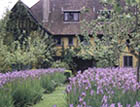Splendours of Irish sibirica
When iris's Siberian eyes are smiling, it is even more of a pleasure to spend time in the garden, finds David Wheeler.


May 25, 2006
The delicate looking flowers of Iris sibirica are borne on one of the northern temperate world's toughest plants. Its specific name reveals all, although in addition to its eponymous far-eastern Russia, this fibrous rooted iris also grows wild in north-east Turkey, and a number of eastern European countries. It is said to revel in damp places; indeed, I have seen it rampant as a marginal plant in shallow water in a garden on Long Island and in a bog in north Wales. Yet, it is adaptable: in a previous life, I succeeded with it on a south-facing terrace on well-drained, light sandy soil.
Despite its hardy stature and ability to adjust to extreme growing conditions, Iris sibirica is no thug. And although this iris bulks up quickly, it does not break loose in the way of, say, ground elder or comfrey. (A wide crescent of Symphytum caucasicum planted in shade several years ago has not only run into nearby borders, but has seeded itself about the rest of the garden rather too generously!)
The many Siberian hybrids, bred from Iris sibirica crossed with I. sanguinea (a closely related species) have all the best qualities of the parents, and their flowers stand proud of tall, slim, grass-like foliage. Coincidentally, the National Collection is held at Lingen Nursery, no more than two miles from our garden at Bryan's Ground on the Welsh border. Our irises, however, came with us from our previous garden in mid Wales.
I had bought them for a formal scheme and dug a few clumps when we moved to place them in the new orchard. That was planted to replace an earlier orchard flanking the drive which, gossips say, was felled by our predecessor. Apparently, he complained of not being able to see his fine house when he turned in from the lane.By blowing the dust from old labels in the apple store, we discovered the names of some varieties which had previously grown here. King's Acre Pippin and Stoke Edith Pippin reflect local Herefordshire placenames, and, this being a county famed for its apples (and its cider), we chose an assortment of trees which bear fruit for the table, the kitchen and the pitcher.
After planting the orchard 10 years ago, we left the grass to grow, enjoying the wild flowers that once more flourished. By mid July, however, the grass usually collapsed under the weight of summer rain not to mention the scrambling activities of our then pack of seven dogs. The sibiricas' fate was determined when I sought a tough herbaceous perennial that could be substituted for the grass and withstand abuse.
They are in a variety named Papillon, and their veined, fluttering petals might well suggest a flight of pale-blue butterflies that have settled on a field of 4ft-high grass. We planted about 30 pencilslim specimens in a 12ft square beneath each tree, leaving us a pleasing grid of wide paths criss-crossing the orchard. They flower at the end of May and last less than a month, but that is not the end of the story. More flowers appear spasmodically throughout the summer, and the grassy foliage remains upright and handsome. As autumn approaches, the leaves turn a foxy tan colour and the former flower heads are transformed into split, black seedheads, as decorative in themselves as the flowers were four months earlier.
Exquisite houses, the beauty of Nature, and how to get the most from your life, straight to your inbox.
Books dictate that the clumps be lifted, split and replanted every few years, but we have not done this yet. As a result, each orchard square is tightly filled with irises: a 'sea' of blue beneath the blossoming apples a Herefordshire interpretation, perhaps, of southern olive groves adrift among fields of lavender.At the very end of autumn, we cut the irises to the ground and cart the foliage off to rot down in its own frustratingly slow way. This leaves the orchard clear for February's much shallower sea of blue: sheets of Anemone blanda, which continue to flourish and multiply regardless of the irises' thick mat of roots.
We have also planted Iris sibirica in the old kitchen garden. Now transformed into a series of colour-themed garden rooms, this half-acre walled enclosure also contains two pools. The largest (30ft by 30ft) is one of our more minimalist attempts at garden design. It is surrounded by stone flags, in turn bounded by a beech hedge that weaves a Greek key pattern through a cloister of pleached hornbeams.
Like the flower-filled border of an illuminated manuscript, the irises fill in between the paving and the hedge: a magical place from which to sit and watch the dragonflies darting over the lily pads on warm summer evenings.
This article first appeared in COUNTRY LIFE magazine on May 25, 2006
Country Life is unlike any other magazine: the only glossy weekly on the newsstand and the only magazine that has been guest-edited by His Majesty The King not once, but twice. It is a celebration of modern rural life and all its diverse joys and pleasures — that was first published in Queen Victoria's Diamond Jubilee year. Our eclectic mixture of witty and informative content — from the most up-to-date property news and commentary and a coveted glimpse inside some of the UK's best houses and gardens, to gardening, the arts and interior design, written by experts in their field — still cannot be found in print or online, anywhere else.
